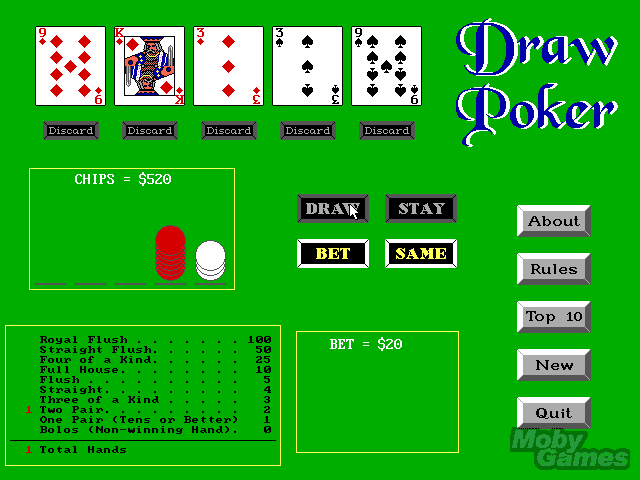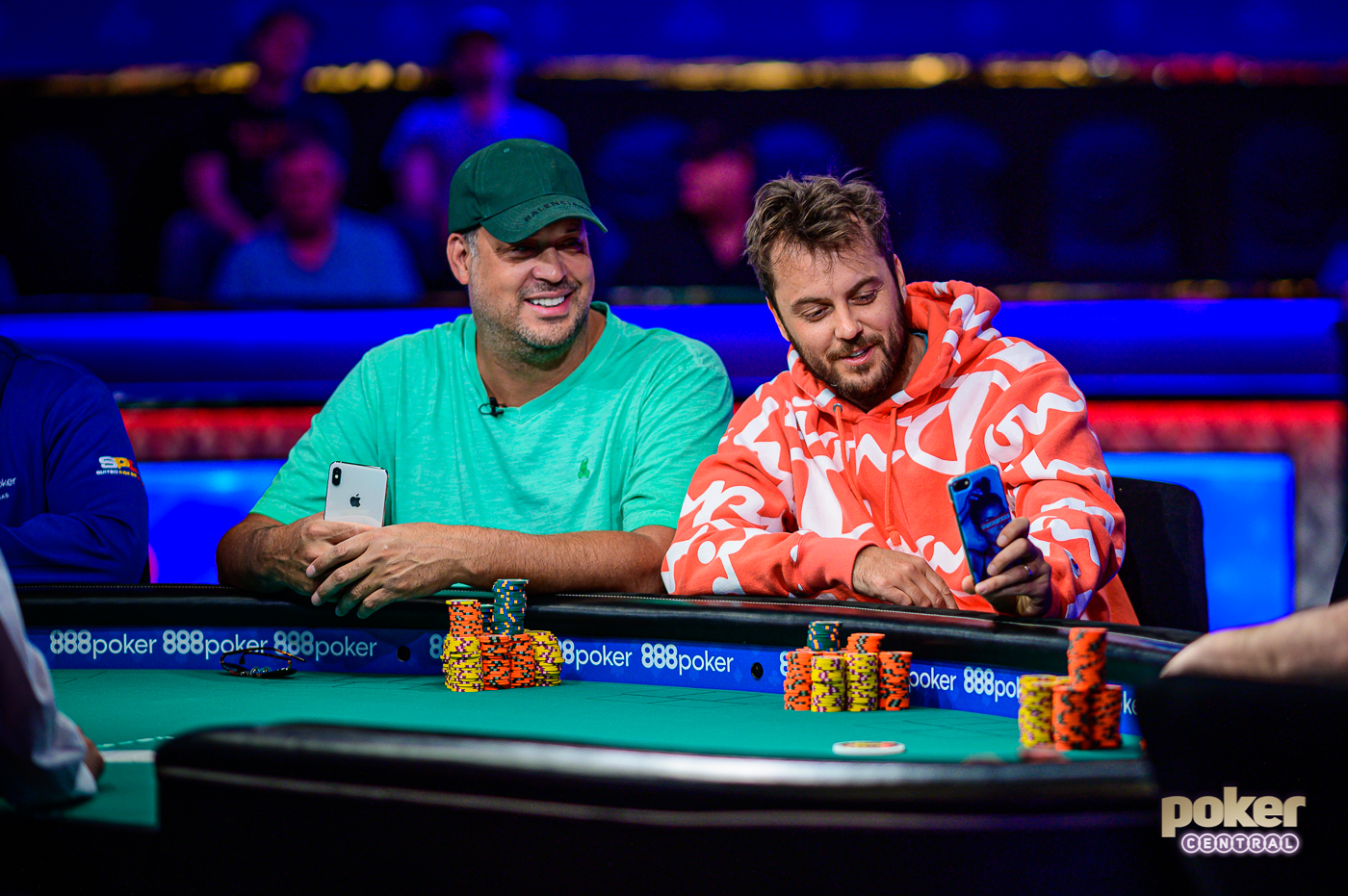Deuce to Seven triple draw is typically played at a table with six players, and the single draw variation usually is played at a table with seven players. Since each player receives a minimum of five cards, you can't really have more than 6 or 7 players at the table because the deck would run out of cards. Triple Draw is usually played as a fixed limit game where as Single Draw is played as a no limit game. The advice we gave in this article is only a blanket introduction to 2-7 lowball strategy. This game is much more situational, and involves reads, tells, studying an opponent, and playing the meta-game more than any other variant of poker. Online 2-7 (Deuce to Seven) Single Draw, also known as Kansas City Lowball, is a draw poker game where the player with the best low hand wins the pot. As in most forms of poker, 2-7 Single Draw uses a standard 52-card deck that is shuffled before every hand. Draw poker is any poker variant in which each player is dealt a complete hand before the first betting round, and then develops the hand for later rounds by replacing, or 'drawing', cards. 1 The descriptions below assume the reader is familiar with the general game play of poker, and with hand values (both high and low variations).
Raise First In
Our Objective
Our primary focus when playing 5-card draw should be attempting to make three-of-a-kind. We look for decent pairs and then draw 3 cards hoping to make trips. Drawing three gives us statistically the highest chance to make trips. You will often see players at your limit holding on to one of their kickers and drawing only two cards, but in most cases this is incorrect.The exception is that there are already 2 limpers in the pot, in which case it's fine to limp behind some straight-draws and flush-draws, but gut-shots should typically be folded. We don't want to make hard and fast rules here but there are some exceptions vs passive opponents where we can get away with cold-calling these hands for one of the two following reasons in a no-limit-game
- Our opponent just can't fold at showdown and hence we have great implied odds. (Note that this applies purely to no-limit 5-card draw games and it's nearly always going to be a mistake to call a raise preflop with a straight-draw or flush-draw in a limit game)
- Our opponent plays extremely face up on the final street and we can pick up pots as a bluff. (Note that again this applies more frequently to no-limit games as our opponent is less likely to fold anything to a min-bet in a limit game)
RFI Ranges
- UTG KKxxx+
- MP QQxxx+
- CO JJxxx+
- BTN 99xxx+
- SB TTxxx+ (however it's OK to complete some weaker hands with reasonable potential)
Isolating
Pairs lower than JJxxx are referred to as “shorts” and are generally considered trouble hands in 5-card draw, so play with caution. These should often be folded preflop, but again it is somewhat villain dependent. We might be able to play some smaller pairs as limp-behinds and take the opportunity to turn them into a bluff on the river vs face up opponents.
The Draw
What Is Single Draw In Poker Room
- If we have a pair we draw 3 and try and make trips.
- If we have trips, we draw two and try to make Quads or a boat.
- If we have a flush-draw or straight-draw we draw one and try to hit.
- If we have total garbage (usually in a free play situation) we can hold on to cards above a Queen or Jack and replace the others.
Hand Reading

3 cards – In most cases this will indicate that the player has a pair and is trying to pick up three-of-a-kind. A very bad player might be drawing to a flush or straight with only 2 cards. It's always worth taking a note of this kind of thing if you discover at showdown that the player drew 3 cards and does not even have a pair when he shows down.
Showdown

Advanced Tactics


Our opponent will often call with 2-pair in this situation hoping to either beat our 2-pair or bluff-catch against our busted draws. In other words, drawing 1 allows us to represent a weaker range with a strong hand. Note that this only makes sense against semi-decent opponents. The average fish may not even care how many cards we draw, in which case we should always draw 2 with trips and give ourselves the maximum chance of improving.
Our opponent will usually fold unless he improve to trips or better. And even if he has trips it won't theoretically be a correct call unless he expects us to be bluffing like this since we are representing a 5-card hand which beats his trips. Obviously we have to be careful not to over-use this line. If we stand-pat every hand it's going to become obvious pretty quickly that we don't have anything.
Using Position to Bluff

- They would lead for value if they hit a strong draw
- They would lead for value a decent amount if they had 2 pair
- It's overall pretty unlikely that they'll spike their draw
So if our opponent has a tendency to go for hugely unlikely draws then we can defend much wider in position even with some weak hands ourselves. We might not get the pot-odds to defend the hand, but if our opponent simply check folds final-street every time he misses, our preflop odds don't matter.
In Summary
Gameplay of 2-7 No Limit Single Draw
Setting Up
- You'll need: a button, small & big blinds (similar to Texas Hold'em).
- Deal each player 5 cards, face down.
- Use a no limit betting structure.
The Action
- Action starts to the left of the big blind. You may fold, call or raise.
- After the 1st betting round, draw 0-5 cards. Then betting resumes to the left of the button.
Determining a Winner
- Worst possible hand wins, so the best hand is the wheel (2-3-4-5-7 offsuit).
- Note: Straights and flushes DO count against you in this game, and aces play as high only.
- The player with the worst hand scoops the pot. In the event of a tie, the pot is split.
Basic Strategies of 2-7 No Limit Single Draw
Pre-Draw
Like most poker games with a button, position is a big factor in 2-7 No Limit Single Draw. Position is more important in this game than in any other form of poker.
Knowing how many cards your opponent draws before you is key to formulating your strategy.
Drawing
As a general rule, you should fold if you must draw more than 1 card.
Never draw 2 cards unless you get a free draw or you start with 3 cards 8 or lower and the bet is small relative to your opponent's stack size.
Adjust the number of cards you draw based on your opponent's play.
Betting
Betting takes place before and after the first draw. If you draw fewer cards than your opponent, you should generally bet.
There is no such thing as slow-playing a big hand since your opponent will see how many cards you draw.
What You Need to Know About 2-7 No Limit Single Draw Starting Hands
Good Starting Hands
Play these hands in all positions (and for a raise):
- All pat hands of 9 or better.
- All 4-card hands 9 or better.
Poor Starting Hands
Never play these hands:
- Hands where you have to draw 3 cards or more.
- Hands with two paired wheel cards.
Marginal Starting Hands
Play these hands cheaply:
- All hands containing 3 cards of 9 or lower.
- All hands containing 2 wheel cards when you only have to complete from the small blind.
Positional Hands
Play in late position when folded to you:
- On the button and hand contains 2 wheel cards and an 8 (occasionally a 9 depending on the blinds).
- In the small blind play any 3-card hands containing 2 wheel cards and an 8 or 9.
2-7 Single Draw
Do's and Don'ts for Better 2-7 No Limit Single Draw Play
Never Limp Early
Because position is so important, you should never limp into a pot in early position.
Try Getting Heads-up
Playing heads-up pots in position is important. Try to reduce the number of players to 2 by raising every time you enter a pot.
Don't Bluff
Bluffing (also called snowing) should be reserved for advanced players, and even then, rarely used.
Famous 2-7 No Limit Single Draw Hands
What Is Single Draw In Poker Games
2-7 No Limit Single Draw: Action from the 2004 WSOP
Players including Howard Lederer, and Chris Ferguson play the WSOP Kansas City Lowball event.
This Video Contains:
- Ferguson doubles up an amateur, 'Jesus heals another cripple'.
- Standard banter among the big names.
2-7 No Limit Single Draw: Barry Greenstein Wins First WSOP Bracelet
Barry Greenstein finishes off Chris 'Jesus' Ferguson for his first ever WSOP bracelet.
This Video Contains:
- Barry Greenstein
- Chris Ferguson
Where Can I Play 2-7 No Limit Single Draw Online?
Single Draw Poker
Try for Free:
Play for Real Money: